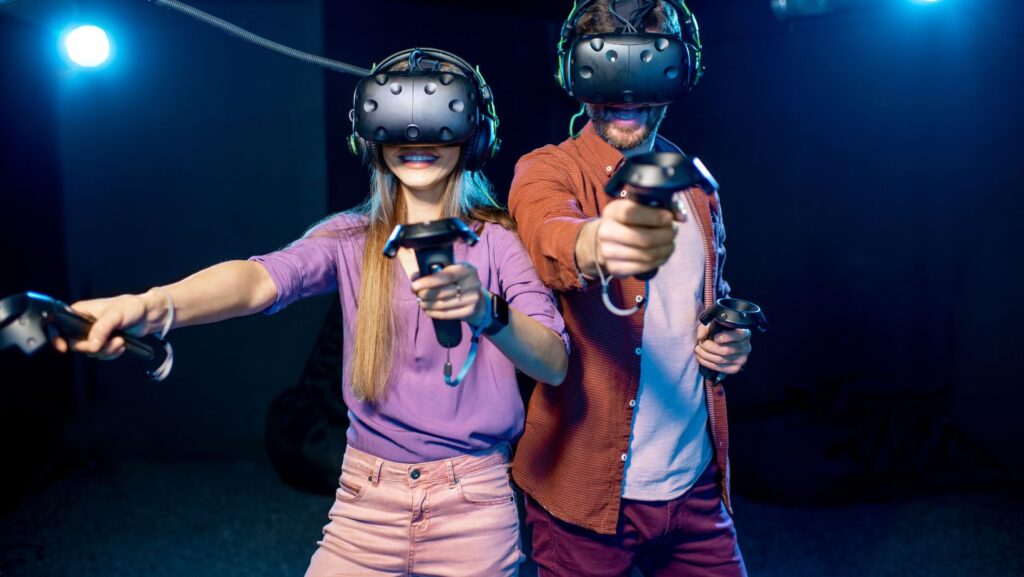As entertainment evolves and experiences become more interactive, audiences are being engaged on a higher level with the aid of digital technology. The digital generation is hungry for participation, interactivity and a personal touch in entertainment options are beginning to adjust accordingly. Ranging from virtual reality (VR) and augmented reality (AR) with interactive streaming content and immersive games, these new types of interactive entertainment are reshaping the way we play, share space, and enjoy. With Glory Casino App you can add up to your digital entertainment options and even win big jackpots. Just give it a try.
VR and AR: Adventures in Immersive Worlds
The Growth of VR Gaming
As far as interactive entertainment goes, this could be considered one of the most immersive kinds you can find to date — that being Virtual Reality (VR). With VR headsets such as Oculus Quest 3 and PlayStation VR2, gamers can enter virtual realms and interact with the surrounding environment in an incredibly realistic manner. Hit video games like Half-Life: Alyx, Beat Saber and No Man’s Sky VR give gamers a massive added sense of immersion; you truly feel like you’re inside the game world. Being able to walk, turn your head and check out the places within the virtual world brings a kind of presence that traditional gaming cannot quite deliver.
Enhanced References in AR and the Real World
On the other hand, Augmented Reality (AR) brings the digital world into to your actual real-world experience by blending with physical surroundings. Games such as Pokémon GO and Ingress are common examples of games that encourage exploration of their surroundings by interacting with objects in the game. Other experiences like museums, theme parks and even live events are employing AR in various forms of entertainment. AR offers a new type of interactive entertainment that features technology and reality interaction by mixing digital elements with the real world, which makes it cool and reachable to anyone.
Streaming and Choose-Your-Own-Adventure Interactivity
Netflix July logistics Finally Turns to Interactive Streaming
The rising popularity of interactive streaming content reflects a growing trend where viewers are choosing more control over the stories they watch. Netflix has led the charge with interactive content, like Bandersnatch and You vs. Audiences feel a sense of control with this format and can experiment with different narratives to create their own unique viewing experience. This kind of interactive content straddles the line between a game and classic television, while also offering a sufficient break from TV to immerse viewers in a new way.
Livestreaming via Twitch and Live Viewer Interaction
One is Twitch, a platform that has really changed what lives content can be with the ability to talk to streamers in real time. In most cases, streamers play games, make art, or simply interact with an audience who can respond through comments and send suggestions or responses to what is taking place. The immediacy of this interaction fosters a sense of community that is incredibly immersive, as viewers transition from being passive consumers to active participants.

There have been acclaimed experiments such as Twitch Plays Pokémon, in which thousands of viewers came together to play one game of Pokémon, proving the effectiveness of interactive streaming.
Playing Immersive Escape Rooms and Augmented Reality Games
Digital Escape Rooms
Escape rooms have always been a crowd-pleaser offering an engaging mix of puzzles, narrative and team endeavor but now they are also in digital formats that provide even more engaging experiences. Instead of requiring players to gather in one location, digital escape rooms can easily be played over the internet, where participants will solve puzzles and find clues through a virtual interface. These experiences are usually still video, audio and puzzles that simulate a real-life escape room experience; they are now available to anyone with an internet connection.
AR-Enhanced Escape Games
Augmented reality escape games are a more developed version of classic escape rooms featuring AR. Using AR technology, players utilize their smartphones or AR glasses to wrestle with puzzles, reveal concealed hints, and interact with digital components that are superimposed on their physical environment. The mix of real-world exploration with digital interactivity makes AR escape games unique, fun-filled to play in all age groups while striking the right balance of physical slipperiness and technology.
Social VR: Building Bonds in Virtual Reality
VRChat and Virtual Hangouts
Platforms such as VRChat and Rec Room are developing new methods of connecting and socializing with one another in virtual settings. A collective virtual space where users can create avatars and enter with other humans into the world of these platforms. From a virtual dance party, a virtual art gallery to simply chilling with friends, social VR offers an interactive way to meet people and have memorable experiences. Unlike traditional social media, the sense of presence associated with VR brings these interactions to life and makes them seem real.
Virtual Events and Concerts
And new from — yes, even foreign lands: virtual events and concerts. Virtual concerts have garnered a global audience of millions, with popular artists such as The Weeknd and Lil Nas X taking to platforms such as Wave and Roblox. These events blend live music with impressive visual effects, interactive components, and audience involvement to create an immersive experience that extends beyond a conventional concert. Fans can attend global events by simply connecting to the internet, eliminating restrictions of location.
Edutainment & Gamified Learning
Games as a medium for interacting with your users
Gamified learning is fast gaining popularity as a new way of making lessons interesting and fun. Platforms like Kahoot! and Minecraft: Education Edition integrates gaming mechanics as learning tools for math, history, and science. These platforms gamify education, transforming learning into an enjoyable process that is accessible to younger audiences. Gamified learning is an interactive way of learning that reigns in better retention and understanding, thus using the tool effectively for both students and educators.
VR and AR in Education: Scientific Knowledge in Your Pocket
Which means also VR or AR is made used to provide immersive education experiences. Instead of sitting on a school bus to visit a historical site, outer space or the deep ocean, students can take VR field trips.

For instance, if a student points their smart device at a textbook it can overlay an interactive 3D model of the anatomical heart or other anatomy on top of the page, bringing subjects such as anatomy or chemistry to life. Such technologies are a fun (but also, useful) way for students to have educational experiences that guide learning in ways through complex ideas.
AI and Personalization: The Future Work of Interactivity
AI-Driven Storytelling
AI has been one of the most foundational tools in interactive entertainment for some time now. AI storytelling platforms such as ChatGPT understand this need, enabling users to craft their stories by engaging with commonly-placed ideas and user experiences of life through the AI-powered story-writing wizard that responds to prompts and shapes your narrative. This is how much control users have over the story, volumizing the creative element of the storytelling and tailoring each experience to individual end-user preference. In gaming, AI is also utilized to create adaptive storylines that respond to player choices and behavior, making the experience more dynamic and immersive.
Tailored Gaming and Entertainment Experiences
Platforms such as Netflix and others have been using AI for years to suggest content based on viewing patterns, but gaming technology also adopts be used in similar fashion where gameplay difficulty level, narrative or your challenges are adapted based on how you play the game. This level of personalization brings entertainment closer, with each experience reflecting individual preferences and interests.
Conclusion: Interactive Learning Outcomes
These games leverage spatial awareness and interactive elements to create a significant difference in both qualitative and quantitative outcomes. As participatory and real-time experiences become more prevalent, the learning process is enhanced through increased accessibility and the crucial role of comparative analysis in digital media.
For the learner, serious games and computer games from 2022 to 2023 have become essential tools, offering a toolkit for acquiring scientific knowledge and fostering critical thinking and problem-solving skills. This evolution underscores the importance of interactive systems and educational material in shaping effective learning and meaningful learning experiences, ultimately providing new opportunities and new possibilities for students using diverse methods of teaching.



